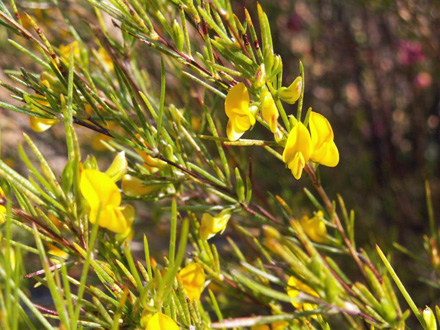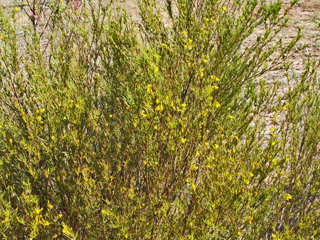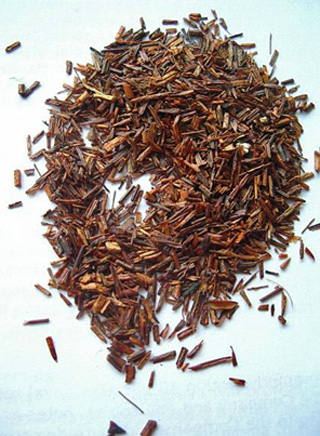Navigation
From a “Red Bush,” Rooibos, Opportunity Is Born in South African Village
With her background in botany, Smith thought of using rooibos – a plant that is a popular tea product and is known across the globe for its medicinal properties.
Nestled in a valley in the Cederberg region of the Western Cape, South Africa’s southern most province, lies the charming little village of Wupperthal.
Activities usually centre round the imposing church in this former Moravian mission station. The village was founded nearly 200 years ago by missionaries who named it after a town in Germany.
Situated in mountains 75 kilometres from the nearest town Clanwilliam, Wupperthal is isolated and poverty in the small community is rife.
 |
| Rooibos, Aspalathus linearis (N.L.Burm.) flower . Taken in Clanwilliam, Western Cape, South Africa Photo by Winfried Bruenken Reprinted from Wikipedia |
Dr Marianna Smith, a leading South African botanist living in Cape Town, some 300 km from Wupperthal, has secured long-term incomes and part-ownership for six previously unemployed women in a business specialising in the manufacture of cosmetic products, Red Cedar. The basis of the products is the indigenous rooibos (literally "red bush") plant that is endemic to the region.
With her background in botany, Smith thought of using rooibos – a plant that is a popular tea product and is known across the globe for its medicinal properties.
Red Cedar has seen steady growth over three years. In 2005 exports were worth 3,000 dollars, compared to the 2008 figure of 8,500 dollars. At the same time the total income from trade increased from a mere 8,400 dollars to 24,500 dollars.
 |
| Rooibos, Aspalathus linearis (N.L.Burm.) R.Dahlgr., plant. Photo taken in Clanwilliam, Western Cape, South Africa Photo by Winfried Bruenken Reprinted from Wikipedia |
Today, Red Cedar is a registered export company and products are sent to clients in the UK, U.S., Holland and Germany. "Currently 40 percent of our trade is with Germany," Smith explained. "The Germans are crazy about rooibos."
According to studies done by Smith, the first European to realise the economic potential of rooibos was Benjamin Ginsberg, an immigrant from Russian descent who started exporting it in small amounts in 1904.
During World War Two it became difficult to obtain tea from Ceylon and this led to an increased demand for rooibos tea.
The product was popularised by South African Annique Theron who realised a bottle filled with Rooibos tea calmed her colicky baby. Over four decades she built up a multi-million dollar beauty empire using rooibos tea as the basis of her products.
 |
| Rooibos ready to put in water. Photography by Laubrau Reprinted from Wikipedia |
Today rooibos in all its forms can be found on the shelves of shops all over the world and rooibos tea is served in five star hotels and restaurants globally.
"I first visited Wupperthal in 2002 and immediately fell in love with the place," says Smith. "But I also saw the poverty and decided to do something."
In 2004 she secured financial aid from the U.S. Agency for International Development (USAid) and Red Cedar was born. The business has since become independent and is functioning without donor funding.
"Initially we only made brown soap. After a while I could not stand the idea of making brown soap for the rest of my life and we expanded into other cosmetics, including body and hand creams and bath products," said Smith who has scaled down her once-a-month visits to Wupperthal to twice a year.
Initially 12 women from the community started with Red Cedar but, as the months passed, some opted out and left a core group of six women who each have a 15 percent share in the company. Smith holds 10 percent of the shares.
The women buy a basic unscented, plain colored soap to which they add essential oils and rooibos extract, turning it into the unique products called Red Cedar. "There are few opportunities in Wupperthal. Most women are mothers and stay at home," Claudia Goes (44), one of the Red Cedar shareholders, told IPS.
"When my husband became ill, I jumped at the chance to become involved with Red Cedar. My husband is fine now, but with my earnings the quality of our lives has improved."
Goes says she is delighted that she has learnt a skill that she can pass on to others in her community.
Jessica Mouton (27) used her first earnings from Red Cedar to invest in a rooibos plantation. "The church set aside some land for community members which we could rent. I now have a rooibos field of about one hectare. I sell the raw product to traders."
While Mouton’s rooibos land is easily accessible, Anna Skippers (27) needs at least two days if she wants to visit the piece of ground which she also rents from the church.
"By the time I wanted to obtain a piece of land, the prime spots were already taken. My land lies in an inaccessible area and can only be reached with a 4 X 4. Because I do not have a vehicle, I have to walk there. But it is far from Wupperthal. I usually have to spend a night at friends on the way there."
But, she says, the inconvenience of traveling to her farm is well worth the effort as it supplements her income from Red Cedar. "I also like the idea that some of my own rooibos crops could end up in Red Cedar products," Skippers added.
Linda Bantom (44) was not born and bred in Wupperthal. She only moved there 18 years ago. But she never wants to leave the town. "I love this place. It is beautiful and offers an extremely relaxed lifestyle. Being a part-owner of Red Cedar fills me with a huge sense of pride. Unlike most other women in this area, the six of us can lay claim to the fact that we own our own business.
"In this small community where most people know each other, I feel a sense of achievement."
Rooibos, an endemic plant that is only found in a small region of South Africa, offers a number of medicinal benefits. Scientific studies have shown that it contains minerals and nutrients and is ideal as a fluid replacement for infants and athletes.
"It also contains powerful anti-oxidants such as flavanoids which have anti-viral and anti-bacterial properties," says Smith.
Article by Stephanie Nieuwoudt
Printed with permission from TERRAVIVA Europe (TVE), the European edition of the TERRAVIVA group of periodicals published by IPS-Inter Press Service - The Global News Agency (IPS). November 14, 2008.
A note about rooibos from Wikipedia:
“Rooibos is grown only in a small area in the Cedarberg of the Western Cape province.[1] Generally, the leaves are oxidised, a process often, and inaccurately, referred to as fermentation by analogy with wine-making terminology. This process produces the distinctive reddish-brown colour of rooibos and enhances the flavour. Unoxidised "green" rooibos is also produced, but the more demanding production process for green rooibos (similar to the method by which green tea is produced) makes it more expensive than traditional rooibos.”
Search
Latest articles
Agriculture
- World Water Week: Healthy ecosystems essential to human health: from coronavirus to malnutrition Online session Wednesday 24 August 17:00-18:20
- World Water Week: Healthy ecosystems essential to human health: from coronavirus to malnutrition Online session Wednesday 24 August 17:00-18:20
Air Pollution
- "Water and Sanitation-Related Diseases and the Changing Environment: Challenges, Interventions, and Preventive Measures" Volume 2 Is Now Available
- Global Innovation Exchange Co-Created by Horizon International, USAID, Bill and Melinda Gates Foundation and Others
Biodiversity
- It is time for international mobilization against climate change
- World Water Week: Healthy ecosystems essential to human health: from coronavirus to malnutrition Online session Wednesday 24 August 17:00-18:20
Desertification
- World Water Week: Healthy ecosystems essential to human health: from coronavirus to malnutrition Online session Wednesday 24 August 17:00-18:20
- UN Food Systems Summit Receives Over 1,200 Ideas to Help Meet Sustainable Development Goals
Endangered Species
- Mangrove Action Project Collaborates to Restore and Preserve Mangrove Ecosystems
- Coral Research in Palau offers a “Glimmer of Hope”
Energy
- Global Innovation Exchange Co-Created by Horizon International, USAID, Bill and Melinda Gates Foundation and Others
- Wildlife Preservation in Southeast Nova Scotia
Exhibits
- Global Innovation Exchange Co-Created by Horizon International, USAID, Bill and Melinda Gates Foundation and Others
- Coral Reefs
Forests
- NASA Satellites Reveal Major Shifts in Global Freshwater Updated June 2020
- Global Innovation Exchange Co-Created by Horizon International, USAID, Bill and Melinda Gates Foundation and Others
Global Climate Change
- It is time for international mobilization against climate change
- It is time for international mobilization against climate change
Global Health
- World Water Week: Healthy ecosystems essential to human health: from coronavirus to malnutrition Online session Wednesday 24 August 17:00-18:20
- More than 400 schoolgirls, family and teachers rescued from Afghanistan by small coalition
Industry
- "Water and Sanitation-Related Diseases and the Changing Environment: Challenges, Interventions, and Preventive Measures" Volume 2 Is Now Available
- Global Innovation Exchange Co-Created by Horizon International, USAID, Bill and Melinda Gates Foundation and Others
Natural Disaster Relief
- STOP ATTACKS ON HEALTH CARE IN UKRAINE
- Global Innovation Exchange Co-Created by Horizon International, USAID, Bill and Melinda Gates Foundation and Others
News and Special Reports
- World Water Week: Healthy ecosystems essential to human health: from coronavirus to malnutrition Online session Wednesday 24 August 17:00-18:20
- STOP ATTACKS ON HEALTH CARE IN UKRAINE
Oceans, Coral Reefs
- World Water Week: Healthy ecosystems essential to human health: from coronavirus to malnutrition Online session Wednesday 24 August 17:00-18:20
- Mangrove Action Project Collaborates to Restore and Preserve Mangrove Ecosystems
Pollution
- Zakaria Ouedraogo of Burkina Faso Produces Film “Nzoue Fiyen: Water Not Drinkable”
- "Water and Sanitation-Related Diseases and the Changing Environment: Challenges, Interventions, and Preventive Measures" Volume 2 Is Now Available
Population
- "Water and Sanitation-Related Diseases and the Changing Environment: Challenges, Interventions, and Preventive Measures" Volume 2 Is Now Available
- "Water and Sanitation-Related Diseases and the Changing Environment: Challenges, Interventions, and Preventive Measures" Volume 2 Is Now Available
Public Health
- Honouring the visionary behind India’s sanitation revolution
- Honouring the visionary behind India’s sanitation revolution
Rivers
- World Water Week: Healthy ecosystems essential to human health: from coronavirus to malnutrition Online session Wednesday 24 August 17:00-18:20
- Mangrove Action Project Collaborates to Restore and Preserve Mangrove Ecosystems
Sanitation
- Honouring the visionary behind India’s sanitation revolution
- Honouring the visionary behind India’s sanitation revolution
Toxic Chemicals
- "Water and Sanitation-Related Diseases and the Changing Environment: Challenges, Interventions, and Preventive Measures" Volume 2 Is Now Available
- Actions to Prevent Polluted Drinking Water in the United States
Transportation
- "Water and Sanitation-Related Diseases and the Changing Environment: Challenges, Interventions, and Preventive Measures" Volume 2 Is Now Available
- Urbanization Provides Opportunities for Transition to a Green Economy, Says New Report
Waste Management
- Honouring the visionary behind India’s sanitation revolution
- Honouring the visionary behind India’s sanitation revolution
Water
- Honouring the visionary behind India’s sanitation revolution
- Honouring the visionary behind India’s sanitation revolution
Water and Sanitation
- Honouring the visionary behind India’s sanitation revolution
- Honouring the visionary behind India’s sanitation revolution

